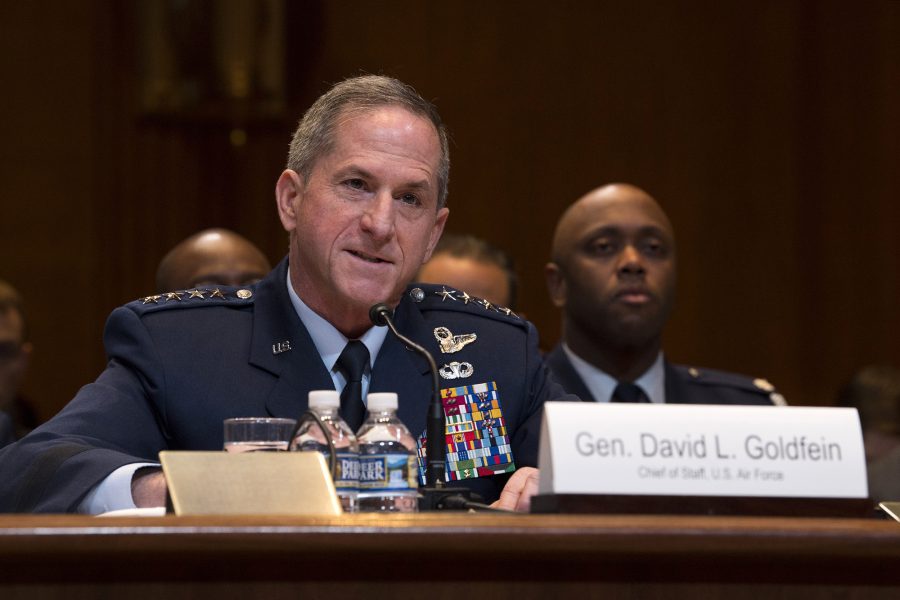The Air Force budget about to go to Congress will create some “real-time, near-term risk” in the service’s ability to conduct a war with a peer adversary, but that risk pays for inter-service connectedness that will be a war-winner in the long term, Chief of Staff Gen. David Goldfein said Jan. 27.
“We had a good meeting this morning” with Defense Secretary Mark Esper, Goldfein reported at a “fireside chat” at the Center for New American Security. There is general agreement among the services about the direction of the 2021 budget, which he said will be an “acceleration of what we’ve been doing the last four years.”
The Air Force wants to shift $30 billion from traditional, “platform-oriented” missions into inter-service connectivity, which Goldfein said is “absolutely critical” if the US is to prevail in future conflicts.
“We didn’t get everything we put on the table,” Goldfein noted, saying some of the cuts USAF proposed were “walked back” by Defense Department leaders or the White House, but generally the service’s proposals are intact, he reported.
The cuts were made after exhaustive analysis and wargames that showed connectivity between sensors and shooters, both within the Air Force and with its sister services, outweighed having as many platforms, Goldfein said.
“It’s been a long time” since the US came out on top in the “most stressing” wargames, Goldfein said, noting that until recently, such exercises “didn’t end well.” But in the notional 2030 force with the connectivity USAF is proposing, the US prevailed. “I can’t tell you how good a feeling it is knowing … it’s going to work,” he said.
As usual, the Air Force budget will be a tightrope walk between “readiness, capacity, and risk,” Goldfein said.
There are four major themes underlying the Air Force’s fiscal ’21 budget proposal, he said. They are:
- Inter-service connectivity for “the joint fight.”
- Investment in space operational capability
- Investment in stand-in and standoff capabilities
- Investment in logistics
Goldfein said the US has to be able to deter an adversary from attacking it in space. “They need to know you can punch back,” he said, noting the new budget will discourage an adversary from even trying such a strategy. The US will have “exponential” new space defense capability. It will also have a larger and more resilient space network, making an attack against it a pointless endeavor, Goldfein said.
Simulations show that when war starts in space “everybody loses … They have to know they can’t win if they go there.”
Wargames also have proved that an all-penetrating or all-standoff approach didn’t do the job, prompting the need for investment in both capabilities.
As for the fourth major theme—logistics—Goldfein said the US military leadership has decided it can no longer assume “unfettered access” to anywhere it wants to set up for war. The new budget will both expand logistics capabilities and invest in their security. The goal will be “move to win,” he reported, and USAF will be striving for “less footprint” when it deploys for war.
Both the Army and Navy service chiefs have recently spoken out publicly, arguing that their branches need a bigger share of the defense budget. Asked if he would also argue for a bigger USAF budget, Goldfein declined, saying that “budget paranoia is a service core competency.” He insisted that “going after each other” is a waste of time.
“I’m not going to jump in to that,” he added.
He said the Air Force and Space Force “have to get it right” as they divide the responsibilities for air and space activities. “What do we build?” he asked rhetorically. “Two services based on trust and confidence, or a divisive split? Is this a marriage or a divorce?” He and Space Force Chief Gen. John Raymond are aiming for a well-coordinated approach of “two chiefs, one mission.” He said
“We can’t let [the two services] drift too far apart,” he said, maintaining that establishing the Space Force was an “exactly right” decision. But Space Force also must have “room to grow” and develop its own culture, he added.
Goldfein said he is open to the idea of revisiting the 1948 Key West agreement that set the roles and missions of the services, as long as it’s “not a budget drill.”
The Army has recently said its hypersonic weapons program will be used to accomplish deep strike, interdiction and suppression and destruction of enemy air defenses (SEAD and DEAD)—all longstanding USAF roles—but Goldfein said he doesn’t believe the Army is poaching USAF’s mission set. Redundancy is “not a bad thing” as long as budgets will sustain it, he said.
He declined to describe what should happen if budgets go flat and choices must be made as to which service should carry out those missions. However, he said there is too much emphasis on the “finish” aspect of the mantra, “find, fix, finish,” and said it doesn’t matter as much what mechanism is used to destroy a target as it is to be able to rapidly locate and characterize it.
Asked by Air Force Magazine if the Army’s entrée into long-range strike could potentially undercut USAF’s B-21 bomber program, Goldfein said the new bomber is enshrined in the Nuclear Posture Review and won’t be threatened by the Army’s long-range shift.
